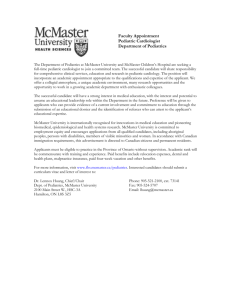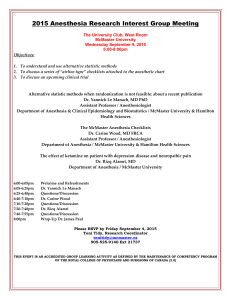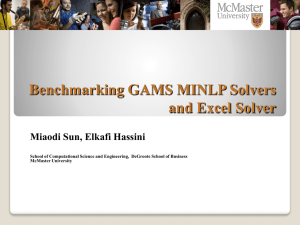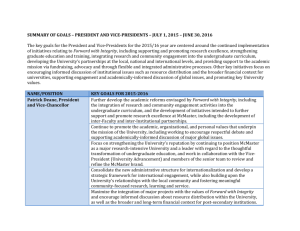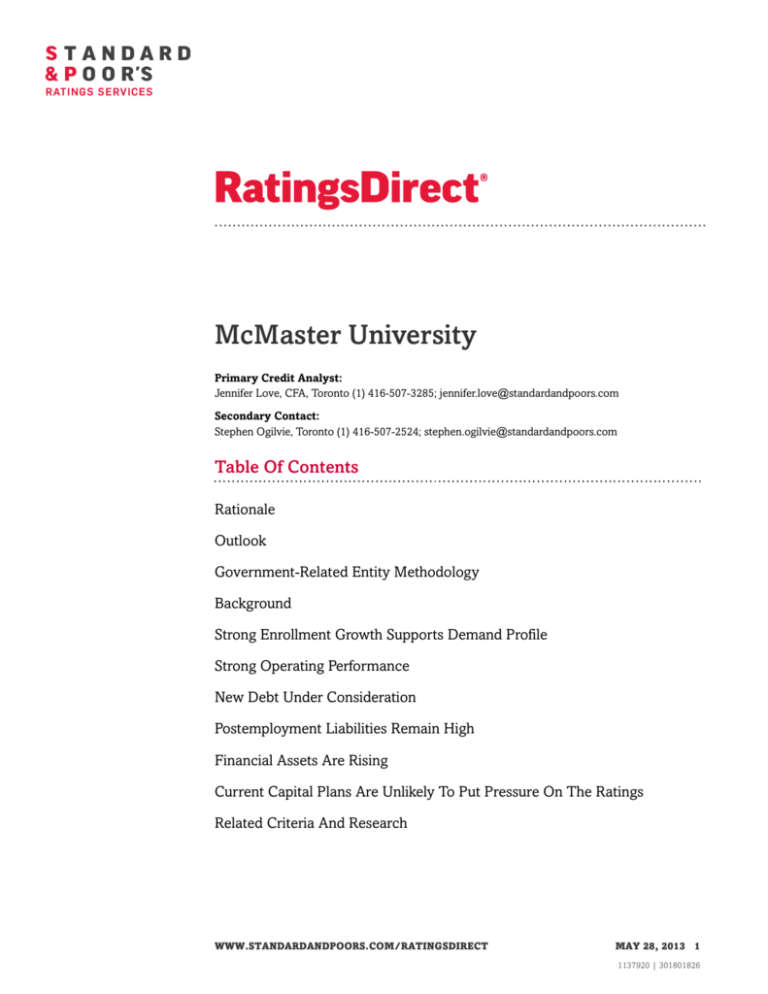
McMaster University
Primary Credit Analyst:
Jennifer Love, CFA, Toronto (1) 416-507-3285; jennifer.love@standardandpoors.com
Secondary Contact:
Stephen Ogilvie, Toronto (1) 416-507-2524; stephen.ogilvie@standardandpoors.com
Table Of Contents
Rationale
Outlook
Government-Related Entity Methodology
Background
Strong Enrollment Growth Supports Demand Profile
Strong Operating Performance
New Debt Under Consideration
Postemployment Liabilities Remain High
Financial Assets Are Rising
Current Capital Plans Are Unlikely To Put Pressure On The Ratings
Related Criteria And Research
WWW.STANDARDANDPOORS.COM/RATINGSDIRECT
MAY 28, 2013 1
1137920 | 301801826
McMaster University
Rationale
The ratings on McMaster University, in Hamilton, Ont., reflect Standard &
Issuer Credit Rating
Poor's Ratings Services' view of the university's strong enrollment demand
AA-/Stable/--
profile, good budgetary performance, and low debt burden. In our opinion,
McMaster's rising unfunded postemployment liabilities remain a credit concern, but we believe the university is taking
steps to mitigate this. In addition, McMaster has lower unrestricted financial resources than those of many rated peers.
The ratings also reflect our assessment of the tight operating environment in which Canadian universities and their
supporting provincial governments operate.
McMaster benefits from what we consider to be strong demand and a good research profile, due to its broad range of
program offerings, high research intensity, and close proximity to the Greater Toronto Area. Its enrollment was 26,353
full-time equivalent students (FTEs) in fiscal 2013 (year ended April 30), exceeding fiscal 2012's enrollment by 1.6%.
We believe student quality is good; the average entering grades are high, as are graduation rates.
McMaster's management has been effective in controlling expenditures, resulting in what we view as good budgetary
performance. However, the university has budgeted for operating fund (which accounts for 58% of fiscal 2014 total
expenditures) deficits through 2015, although the operating budgets are balanced before one-time expenses. In
addition, McMaster has taken steps to improve its unfunded postemployment benefits, including increasing the
employee contribution rate for the pension plans and changes to other postemployment benefits.
In our opinion, the university exhibits prudent debt management and benefits from a low debt burden. McMaster's
debt was C$139.4 million or C$5,376 per FTE at fiscal 2012 year-end. It has steadily reduced its debt stock in every
year but one since going to market with its first and only debenture issue in September 2002. McMaster has the lowest
debt burden of its rated peers, although we believe it may issue debt to fund capital and strategic projects. In addition,
the university has established its own debt-monitoring policy to guide financial planning, internally financed its capital
projects, and created voluntary debt retirement funds for its debenture.
McMaster has large unfunded postemployment benefits, including two defined benefit pension plans. While the
university has taken steps to reduce these liabilities, their ongoing funding requirements put pressure on its budget.
McMaster's unfunded registered pension liability increased to C$281.5 million (up from C$211.0 million in 2011) and
its total unfunded postretirement benefit obligation is C$571.0 million. The university will make special payments of
C$20.8 million per year in fiscal 2013 and 2014 in respect of its pension liability and will continue to pay the other
postemployment liabilities as they arise.
McMaster's unrestricted financial resources (internally restricted endowment plus internally restricted net assets) are
lower than many of its rated peers. The university's unrestricted financial resources have risen in the past two years
and now stand at C$123 million, or C$4,743 per FTE; however, they remain well below their highest levels at C$235.9
million (or C$10,299 per FTE) in fiscal 2007 and below the peer average. The decline was in part a result of the
WWW.STANDARDANDPOORS.COM/RATINGSDIRECT
MAY 28, 2013 2
1137920 | 301801826
McMaster University
university's decision to use its internal resources to fund some one-time operating costs (going-concern pension deficit
and early retirement program in fiscal 2008) and internal financing of loans for capital projects. While internal
financing of capital projects has kept debt at a relatively low level, it also limited McMaster's financial flexibility. If the
university continues to finance capital and strategic projects through internal loans, we would expect financial
flexibility to remain limited. However, if it were to finance capital and strategic projects through external borrowing
this could increase financial flexibility as well as the debt burden.
Outlook
The stable outlook reflects our expectation that McMaster's student demand and research profile will remain strong
and that it will continue to generate consolidated surpluses and maintain its unrestricted financial resources around
current levels. Furthermore, we assume the Province of Ontario will not significantly cut the university's funding
without providing greater tuition-setting flexibility. Standard & Poor's could lower the ratings if these assumptions are
not met, or if we downgrade the province. Conversely, we could raise the ratings if McMaster's unrestricted financial
resources rise to their former levels and debt remains relatively low.
Government-Related Entity Methodology
In accordance with our criteria for government-related entities, our view of a "moderately high" likelihood of
extraordinary government support reflects our assessment of McMaster's "important" role in the province, given that
postsecondary education is the top of Ontario's priorities in both expenditure and mandate after health care and
primary and secondary education. The assessment also reflects our view of the university's strong reputation in the
country and its significant research capacity. In our opinion, the provincial oversight and directive McMaster receives
through tuition regulation and program approval suggests a "strong" link with Ontario. Also supporting this view is that
provincial operating grants account for a material portion of the university's operating revenues.
The government-related entity analysis incorporates our opinion of Ontario ongoing financial support as well as
McMaster's public policy role. Grants from senior levels of government account for 46% of the university's total
revenues. The province's large operating deficits have reduced its budgetary flexibility, and we expect financial support
for universities could be constrained in the medium term. Nevertheless, we believe that Ontario will continue to
provide solid financial support to universities and we expect that postsecondary education will continue to play a vital
public policy role.
Background
Founded in 1887, McMaster is a research-intense, doctoral university in Hamilton, the fifth-largest city in Ontario.
McMaster is the fourth-largest of 20 public universities in the province and has regional campuses in Burlington,
Waterloo, and St. Catharines. It draws students primarily from Ontario. In fiscal 2012 (the most recent data available),
89.6% of students (graduates and undergraduates) were from Ontario, while 3.3% came from the rest of Canada and
7.2% were international students. The university celebrated its 125th anniversary in 2012.
WWW.STANDARDANDPOORS.COM/RATINGSDIRECT
MAY 28, 2013 3
1137920 | 301801826
McMaster University
Strong Enrollment Growth Supports Demand Profile
We believe McMaster's strong research profile contributes to it enrollment growth and strong demand profile. It was
ranked as one of Canada's top research universities (achieving sixth place in a 2012 Infosource Inc. report). Moreover,
McMaster has garnered international attention, placing fifth in Canada and within the top 100 universities
internationally in the Times Higher Education rankings. The university's fall 2012 (fiscal 2013) FTE enrollment was
26,353, up 1.6% from the previous year. Its selectivity (offers divided by applicants) was 59% in the fall 2012, and its
yield (registrants divided by applicants) was 15%. Average entering grades for McMaster are high, in our opinion, at
86.3%. We expect enrollment demand and selectivity to remain strong.
Also supporting the university's demand profile is its high first year retention rate, high graduation rate and good
faculty quality. McMaster's retention is what we view as high, with 87% of first-time full-year undergraduate students
of the 2010 entering class continuing to their second year of study. We believe its graduation rate is also high, at
83.5%. In 2012 (most recent data available), 91% of the full-time faculty held a doctoral degree.
Strong Operating Performance
In recent years, McMaster has improved its budgetary performance and made positive changes to its financial
management. Both are contributing to a stronger credit profile, in our opinion. In fiscal 2012, the university posted a
consolidated surplus of $9.1 million or 1% or revenues. Historically, McMaster has prepared separate budgets for its
six funds, with the university's core operating budget being the most significant at about 58% of its forecast 2013
consolidated revenues (its other funds relate to ancillary, research, trust, endowments, and capital). McMaster's fiscal
2013 consolidated budget (approved June 2012) included budgeted operating fund deficits of C$27 million, C$6.5
million, and C$4.7 million in 2013, 2014 and 2015, respectively. These deficits are after one-time spending and were
not indicative of a structural deficit, in the university's view. It is now forecasting a reduced operating fund deficit of
C$14.4 million (including one-time spending), and a consolidated GAAP surplus of C$12.2 million for fiscal 2013.
In 2012, McMaster's total revenue was C$877.9 million, an increase of 2.4% from the previous year, while expenses
rose to C$868.8 million (up 4%). Operating and research grants from the provincial and federal governments are the
source of 46% of the university's revenues (C$404 million). Other important sources of revenues are tuition at 21%
(C$184.3 million) and ancillary sales and services at 8% (C$69.8 million) of revenues. Staff compensation and benefits
are the largest expense, at C$539.3 million or 62% of total expenses.
Ontario universities are facing funding challenges both in terms of the financial support received from the provincial
government and their ability to increase tuition rates. We believe the Ontario government generally provides good
support to its universities; however, the province is projecting a deficit of C$9.8 billion for 2012-2013 and doesn't aim
to return to balance until 2017-2018. While base operating and deferred maintenance grants have been largely stable,
low economic growth forecasts suggest that there will be little room for Ontario to increase its support of universities
and still meet this target. Moreover, the Government of Ontario recently announced a new tuition framework which
caps yearly increases for undergraduate tuition fees at 3% (down from 5% under the previous framework), and caps
WWW.STANDARDANDPOORS.COM/RATINGSDIRECT
MAY 28, 2013 4
1137920 | 301801826
McMaster University
the increases in graduate and professional fees at 5% (down from 8%). The new framework will be effective for four
years starting in fiscal 2014. For planning purposes, McMaster had already assumed a 3% increase in domestic tuition
prior to the announcement and had incorporated that assumption into its budget.
Other financial management initiatives
The university is adopting a new budget model for fiscal 2015. This new model will be partially activity-based and will
allocate revenues to the faculties that generate income through their activities. McMaster believes the new budget
model will contribute to greater transparency and facilitate long-term planning. The university also updated its debt
policy in 2012. In 2013, it approved and began implementation of a system renewal initiative that will support
students, research human resources, finance, and business intelligence, and help the university to standardize and
simplify its processes. Also in 2013, management enhanced its long-term capital planning process and issued three key
reports aimed at a more integrated approach, entitled Facilities Capital Plan, Energy Management Plan, and Asset
Management Plan.
New Debt Under Consideration
McMaster has the lowest debt level (per FTE) of its peers, which supports its credit profile, in our opinion. In fiscal
2012, the university's debt totaled C$161.3 million and included C$139.4 million of long-term debt and a C$21.9
million loan guarantee. This represented C$6,221 per full-time equivalent and 19.1% of adjusted revenues (Standard &
Poor's-calculated). McMaster's debt service coverage ratio rose to 4.6x in fiscal 2012 above the average of its peers at
3.9x, and up from 2.6x in fiscal 2011.
The university's long-term debt consists mainly of a C$120 million debenture, with principal repayment in 2052. It also
includes two bank loans and a mortgage, which total C$19.4 million. McMaster has also guaranteed the debt service
obligations of its research park (The First Longwood Innovation Trust) up to C$23 million. The university has indicated
that it is reviewing its capital and strategic priorities and may consider issuing additional debt in the next two years.
McMaster also has two other long-term obligations, the decommissioning of its nuclear reactor and two interest rate
swap agreements, which total C$15.8 million. Trust funds of C$7.7 million accumulated for the purpose largely offset
the decommissioning obligation, which was valued at C$8.7 million at the end of April 2012.
The university's practice of establishing off-setting sinking funds diminishes its debt burden somewhat, including one
sinking fund set up to repay the bond issue outstanding (valued at C$10.8 million at fiscal year-end). Payments to the
sinking funds are voluntary. Accordingly, we include the sinking funds in internally restricted net assets, but do not
consider them in our calculation of its debt burden.
Postemployment Liabilities Remain High
Many Canadian universities suffered erosion in the funded status of their pension plans in the past few years.
McMaster, which maintains a defined-benefit plan as well as other postemployment liabilities, was no exception. The
university has made considerable gains in managing the growth of the postemployment liabilities, such as changes in
WWW.STANDARDANDPOORS.COM/RATINGSDIRECT
MAY 28, 2013 5
1137920 | 301801826
McMaster University
plan design, revised eligibility rules for some new employees, the introduction of a group registered retirement savings
plan for certain new employees, and increased employee contributions. Nevertheless, the funding deficit remains very
large and will continue to pressure the budget greatly in the medium term.
In fiscal 2012, McMaster's pension assets continued to increase following the recession; however, a large unfunded
liability remains. While the fair value of plan assets rose to C$1.20 billion from C$1.15 billion in 2012, the university
estimated that its unfunded pension liability in its registered pension plans has grown to C$281.5 million, from C$211
million in 2011. Moreover, McMaster's total unfunded postretirement liability (which is primarily attributable to
pensions and health benefits) stands at C$570.7 million in fiscal 2012, up considerably from C$481 million in 2011, and
is one of the highest among its rated peers.
Recent solvency relief reduced payments temporarily
Until 2011, Ontario required institutions to amortize their plans' going-concern deficits over 15 years and solvency
deficits over five. However, in response to the rising number of institutions with large plan deficits, it announced
regulations to partially relax the more punitive solvency amortization requirement. Under the new regulations, the
province requires institutions that want solvency relief to follow a two-stage process. In the first stage, institutions
must submit a funding plan that includes estimated savings targets to improve their plans' sustainability in the long
term. If accepted, institutions will receive a three-year delay on their solvency amortization payments (the solvency
payment exemption period), although they must pay deficit interest and amortize any going-concern deficits over 15
years. At the end of three years, Ontario will require institutions to submit a report that measures progress against the
original savings targets. If deemed satisfactory, the province will permit institutions to take advantage of the second
stage, which lengthens institutions' required amortization period of solvency deficits to 10 years from five.
McMaster received stage 1 relief in 2012 in respect of both its hourly and salaried pension plans and is deferring its
significant solvency payments. However, even with stage 1 relief, the university is facing pension special payments of
C$20.8 million in fiscal 2013 and 2014 (compared with C$59.5 million without solvency relief). It plans to apply for
stage 2 relief. It is planning on building a reserve to help mitigate the budgetary effect of the solvency payments, which
it will begin making in fiscal 2016. The payments will be based on the pension funds' next actuarial valuation, which
must be filed based on July 1, 2014, estimates.
Financial Assets Are Rising
McMaster's financial assets, which include its endowment funds and internally restricted assets, have increased in
value in the past two years, but remain below both their historical high levels and the average level of their peers. The
university's endowment funds stood at C$445.4 million in fiscal 2012, up 0.2% from the previous year, while its
internally restricted financial assets were C$13.2 million, up 106%. McMaster's unrestricted financial resources were
C$123 million in 2012, up 1.4% from 2011. This represents 76% of debt outstanding, which, while strong, is slightly
below the average of its peers.
To achieve economies of scale, McMaster pools its financial assets into one common investment pool. Ongoing
volatility in the capital markets continued to affect the investment fund returns in 2012. The fund's return was positive
10.2% as of Dec. 31, 2012, compared with negative 0.9% in 2011, positive 9.7% in 2010, and positive 15.8% in 2009.
WWW.STANDARDANDPOORS.COM/RATINGSDIRECT
MAY 28, 2013 6
1137920 | 301801826
McMaster University
The volatility could affect the university's ability to maintain the annual allocations for spending from some
endowments. McMaster's payout policy for its endowed funds is an annual allocation of 4.0% of a five-year average of
the endowment's market value (another 1% goes to administration). The university also manages a pool of financial
assets invested in short-term assets. This fund is primarily for working capital needs.
McMaster's fundraising efforts support the growth of financial assets. In 2012, the university surpassed its fundraising
targets by raising C$23.8 million in new pledges and gifts and C$6.5 million in discounted future gifts.
Current Capital Plans Are Unlikely To Put Pressure On The Ratings
McMaster undertakes a five-year capital planning exercise, and gives priority to projects that are mission-critical or
self-supporting. Priorities for 2012 and 2013 include completion of the McMaster Automotive Resource Centre (C$21.6
million) and the beginning of the downtown McMaster Health Campus (C$84.6 million). In addition, the C.R. Wilson
Hall for Humanities and Social Science (C$65.0 million) is to begin construction once planning is finalized and the
board gives approval. The university historically used a revolving fund composed of unrestricted surpluses and
residual amounts from the 2002 bond issue not permanently assigned to building projects to fund some capital
expenditures. However, it could use external borrowing to fund future capital and strategic projects.
Deferred maintenance has been a challenge for McMaster. The university estimates its deferred maintenance was
approximately C$150 million in 2012. While it does receive funding from the province for maintenance, it is insufficient
to cover all deferred maintenance costs. To address its maintenance needs, McMaster has allocated an additional
C$45 million over five years for deferred maintenance projects.
McMaster University--Peer Comparison
--McMaster University-(C$000s)
Issuer credit rating as of May 28, 2013
--York University--
--University of Guelph--
2012
2011
2012
2011
2012
2011
AA-/Stable/--
AA-/Stable/--
AA-/Stable
AA-/Stable
A+/Stable/--
A+/Stable/--
Applicants
32,703
31,046
55,592
58,402
26,543
26,106
Offers
20,151
19,631
42,476
40,879
15,764
15,343
Registrants
5,567
5,109
N.A.
N.A.
5,641
5,332
Acceptance rate (offers/applicants; %)
62
63
76
70
59
59
Yield (registrants/applicants; %)
17
16
N.A.
N.A.
36
35
FTEs
25,929
25,399
48,323
47,894
25,194
23,959
877,851
857,398
956,883
923,016
698,765
678,404
Deferred capital
33,840
34,688
12,041
11,698
23,315
22,442
Adjusted revenue
844,011
822,710
944,842
911,318
675,450
655,962
Total expenditure
868,748
835,447
959,371
926,551
669,227
652,553
Total revenue
Total interest expense
Depreciation
Adjusted expenditure (for DSCR)
Current portion of long-term debt (for
calculating DSCR)
Consolidated surplus (%)
8,694
9,900
19,340
19,591
11,427
11,836
60,999
61,115
41,341
39,959
40,510
39,257
799,055
764,432
898,690
867,001
617,290
601,460
1,028
12,744
630
4,430
7,407
17,543
1.0
2.6
(0.3)
(0.4)
4.2
3.8
WWW.STANDARDANDPOORS.COM/RATINGSDIRECT
MAY 28, 2013 7
1137920 | 301801826
McMaster University
McMaster University--Peer Comparison (cont.)
Consolidated surplus (for calculating DSCR;
%)
5.3
7.1
4.9
4.9
8.6
8.3
DSCR (interest and principal; x)
4.6
2.6
2.3
1.8
3.09
1.86
DSCR (interest only; x)
5.2
5.9
2.4
2.3
5.09
4.60
Total debt
161,300
174,143
306,511
310,941
204,200
185,060
Unfunded postemployment liabilities
570,656
480,964
501,149
361,997
741,327
484,246
1.0
1.2
2.0
2.1
1.7
1.8
Interest expense to adjusted revenue (%)
Debt to FTE
6,221
6,856
6,343
6,492
8,105
7,724
Debt to adjusted revenue (%)
19.1
21.2
32.4
34.1
30.2
28.2
(Debt plus unfunded)/adjusted revenue (%)
86.7
79.6
85.5
73.8
140.0
102.0
Internally restricted net assets
13,187
6,416
115,643
148,502
183,855
156,483
Internally restricted endowments
109,806
114,833
41,087
40,533
19,886
20,133
Externally restricted endowments
335,562
329,272
290,040
290,799
198,666
190,242
Unrestricted financial resources
122,993
121,249
156,730
189,035
203,741
176,616
As % of total debt
76.3
69.6
51.1
60.8
99.8
95.4
As % of total debt plus unfunded
post-employment liabilities
16.8
18.5
19.4
28.1
21.5
26.4
As a % of operating expense
Per FTE
Total endowment value per FTE (at market
value)
Cash and short-term investments
As % of operating expenditures
As % of debt outstanding
14.2
14.5
16.3
20.4
30.4
27.1
4,743
4,774
3,243
3,947
8,087
7,372
20,023
20,201
6,891
7,057
9,058
9,099
184,153
167,916
20,400
48,311
165,585
125,324
21.2
20.1
2.1
5.2
24.7
19.2
114.2
96.4
6.7
15.5
81.1
67.7
FTE--Full-time equivalent. DSCR--Debt service coverage ratio. N.A.--Not available.
Related Criteria And Research
• Methodology For Rating International Local And Regional Governments, Sept. 20, 2010
• USPF Criteria: Higher Education, June 19, 2007
Ratings Detail (As Of May 28, 2013)
McMaster University
Issuer Credit Rating
AA-/Stable/--
Senior Unsecured
AA-
Issuer Credit Ratings History
08-Dec-2010
AA-/Stable/--
09-Sep-2002
AA/Stable/--
*Unless otherwise noted, all ratings in this report are global scale ratings. Standard & Poor's credit ratings on the global scale are comparable
across countries. Standard & Poor's credit ratings on a national scale are relative to obligors or obligations within that specific country.
WWW.STANDARDANDPOORS.COM/RATINGSDIRECT
MAY 28, 2013 8
1137920 | 301801826
Copyright © 2013 by Standard & Poor's Financial Services LLC. All rights reserved.
No content (including ratings, credit-related analyses and data, valuations, model, software or other application or output therefrom) or any part
thereof (Content) may be modified, reverse engineered, reproduced or distributed in any form by any means, or stored in a database or retrieval
system, without the prior written permission of Standard & Poor's Financial Services LLC or its affiliates (collectively, S&P). The Content shall not be
used for any unlawful or unauthorized purposes. S&P and any third-party providers, as well as their directors, officers, shareholders, employees or
agents (collectively S&P Parties) do not guarantee the accuracy, completeness, timeliness or availability of the Content. S&P Parties are not
responsible for any errors or omissions (negligent or otherwise), regardless of the cause, for the results obtained from the use of the Content, or for
the security or maintenance of any data input by the user. The Content is provided on an "as is" basis. S&P PARTIES DISCLAIM ANY AND ALL
EXPRESS OR IMPLIED WARRANTIES, INCLUDING, BUT NOT LIMITED TO, ANY WARRANTIES OF MERCHANTABILITY OR FITNESS FOR
A PARTICULAR PURPOSE OR USE, FREEDOM FROM BUGS, SOFTWARE ERRORS OR DEFECTS, THAT THE CONTENT'S FUNCTIONING
WILL BE UNINTERRUPTED, OR THAT THE CONTENT WILL OPERATE WITH ANY SOFTWARE OR HARDWARE CONFIGURATION. In no
event shall S&P Parties be liable to any party for any direct, indirect, incidental, exemplary, compensatory, punitive, special or consequential
damages, costs, expenses, legal fees, or losses (including, without limitation, lost income or lost profits and opportunity costs or losses caused by
negligence) in connection with any use of the Content even if advised of the possibility of such damages.
Credit-related and other analyses, including ratings, and statements in the Content are statements of opinion as of the date they are expressed and
not statements of fact. S&P's opinions, analyses, and rating acknowledgment decisions (described below) are not recommendations to purchase,
hold, or sell any securities or to make any investment decisions, and do not address the suitability of any security. S&P assumes no obligation to
update the Content following publication in any form or format. The Content should not be relied on and is not a substitute for the skill, judgment
and experience of the user, its management, employees, advisors and/or clients when making investment and other business decisions. S&P does
not act as a fiduciary or an investment advisor except where registered as such. While S&P has obtained information from sources it believes to be
reliable, S&P does not perform an audit and undertakes no duty of due diligence or independent verification of any information it receives.
To the extent that regulatory authorities allow a rating agency to acknowledge in one jurisdiction a rating issued in another jurisdiction for certain
regulatory purposes, S&P reserves the right to assign, withdraw, or suspend such acknowledgement at any time and in its sole discretion. S&P
Parties disclaim any duty whatsoever arising out of the assignment, withdrawal, or suspension of an acknowledgment as well as any liability for any
damage alleged to have been suffered on account thereof.
S&P keeps certain activities of its business units separate from each other in order to preserve the independence and objectivity of their respective
activities. As a result, certain business units of S&P may have information that is not available to other S&P business units. S&P has established
policies and procedures to maintain the confidentiality of certain nonpublic information received in connection with each analytical process.
S&P may receive compensation for its ratings and certain analyses, normally from issuers or underwriters of securities or from obligors. S&P
reserves the right to disseminate its opinions and analyses. S&P's public ratings and analyses are made available on its Web sites,
www.standardandpoors.com (free of charge), and www.ratingsdirect.com and www.globalcreditportal.com (subscription) and www.spcapitaliq.com
(subscription) and may be distributed through other means, including via S&P publications and third-party redistributors. Additional information
about our ratings fees is available at www.standardandpoors.com/usratingsfees.
WWW.STANDARDANDPOORS.COM/RATINGSDIRECT
MAY 28, 2013 9
1137920 | 301801826


